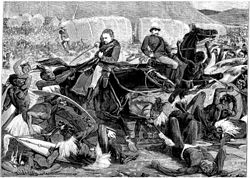伊散德尔瓦纳战役
伊散德尔瓦纳战役(英语:Battle of Isandlwana)发生于1879年1月22日-1月23日,为祖鲁战争先期战争中,极为重要的战役。该战役中,20,000名南非祖鲁人成功伏击了英国远征军进攻至伊散德尔瓦纳的约1,700人前锋。尽管面对着军事装备的巨大劣势,但祖鲁人最后仍以约1千至4千人的代价击败英军,并令英军战死超过1,300人,几乎全军覆没。祖鲁人并趁此机会收复罗克渡口的原本失土。
| 伊散德尔瓦纳战役 | |||||||
|---|---|---|---|---|---|---|---|
| 祖鲁战争的一部分 | |||||||
 泰格茅斯·梅尔维尔 †及内维尔·科吉尔 †两位中尉带着军旗撤退 | |||||||
| |||||||
| 参战方 | |||||||
|
| 祖鲁王国 | ||||||
| 指挥官与领导者 | |||||||
|
安东尼·邓霍中校 † 亨利·普林少校 † |
Vumindaba kaNthati Mavumengwana kaNdlela | ||||||
| 兵力 | |||||||
|
第三纵列 |
祖鲁部队: | ||||||
| 伤亡与损失 | |||||||
|
超过1,300人战死:[3] | 2,000人受伤[10] | ||||||
注解
编辑- ^ All figures from Holme, N. (1999) The Noble 24th: Biographical Records of the 24th Regiment in the Zulu War and the South African Campaigns, 1877–1879 pp. 377–78
- ^ Doyle, p. 120: "... around 20,000 ...". Colenso, p. 313, "The Zulu army, he (Nugwende) says, numbered 20,0000 ..." and p. 312, "... full nominal strength reaches a total of 30,900 men but the actual numbers are estimated at from 20,000 to 25,000
- ^ Knight (2002), p. 86
- ^ 4.0 4.1 4.2 Giliomee, Hermann; Mbenga, Bernard. New History of South Africa First. Tafelberg Publishers. 2007: 166. ISBN 978-0-624-04359-1.
- ^ Smith-Dorrien, Chapter 1D, "... nearly 900 British and 2,000 or 3,000 natives, friend and foe, had breathed their last on the fatal 22nd."
- ^ Lock, p. 224
- ^ Colenso, p. 312, gives 1333 also states a "given" total as 822 but says the actual loss is slightly higher
- ^ Knight, Ian. Isandlwana 1879: The Great Zulu Victory, Osprey, 2002, p. 86, "Zulu casualties were almost as heavy (as the British). Although it is impossible to say with certainty, at least 1,000 were killed outright in the assault...". Knight's estimate of Zulu casualties is more in keeping with those suffered by the Zulu at Kambula, where a British column forms an excellent defensive position with a wagon lager, six 7 pounder artillery pieces and 2,000 soldiers and inflicts 800 (counted bodies) – 1,000 killed on the Zulu. Similarly, Knight & Castle. Zulu War 1879: twilight of a warrior nation, 1992, p. 54 and in their Zulu War, 2004, p. 114, state that the Zulu casualties at Kambula and Isandlwana are comparable. Again, Ian Knight. Brave Men's Blood, The Epic of the Zulu War, 1879, (1990), p. 142, "785 [bodies] were collected from close by the camp", while there is a British pursuit at Kambula that inflicts many casualties on the Zulu, there is only the British retreat at Isandlwana during which the Zulu inflict many casualties. Also Laband, Historical Dictionary, 2009, p. 123.
- ^ Smith-Dorrien, Chapter 1D, "The next few days after the battle, St. Matthew's simile, " Wheresoever the carcase is, there will the eagles be gathered together," was fully illustrated, for literally the sky was darkened at times by continuous streams of " Aasvogels " heading from all directions to the battlefield marked by that precipitous and conspicuous crag, like a lion couchant, " Isandhlwana " where nearly 900 British and 2,000 or 3,000 natives, friend and foe, had breathed their last on the fatal 22nd." As can be seen from this account there were from both sides a total of 2 to 3 thousand natives killed.
- ^ Victor David Davis Hanson, "Carnage and Culture: Landmark Battles in the Rise to Western Power", p. 282, Anchor Books, 2002. Hanson highlights Zulu accounts of how simply being hit by a Martini Henry .45 slug was usually enough for a crippling or maiming wound and in the absence of effective medical care, many wounded Zulus died, within several hours or a few days as result of wounds sustained at Isandlwana.